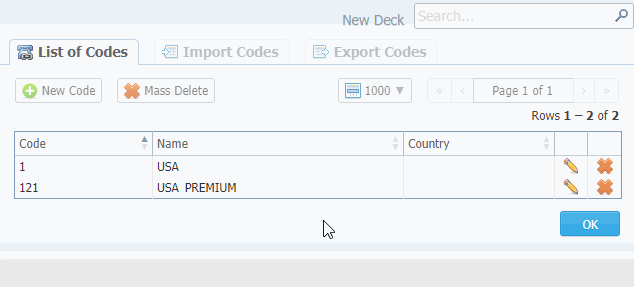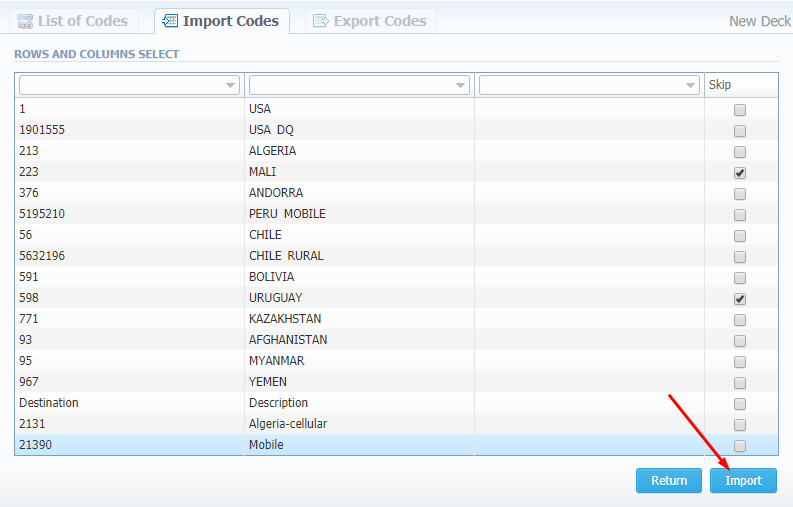Code Decks
Section overview
Code Deck is a list of destination codes, each with its corresponding name and country it represents (optional). A Code Deck is by far one of the key elements of any Rate Table and is used pretty much throughout the whole system (sections like Invoices, Packages, etc.). By having multiple Code Decks, you can freely operate with different names for the same codes and change them in real-time.
The section is presented in the form of a list of all existing code decks in the system:

| Column | Description |
|---|---|
| ID | Code Deck's identification number |
| Deck Name | Name of a code deck |
| Quantity | Number of Codes within a Code Deck |
| Reseller | List of resellers corresponding deck was assigned to |
Functional buttons/icons, presented in the section, are as follows:
| Button/Icon | Description |
|---|---|
 | Allows to create a new Code Deck |
 | Allows to manage an existing Code Deck on a list |
 | Allows deleting a Code Deck from the system. Requires confirmation |
Creating a new Code Deck
To create a new Code Deck:
- Click the New Code Deck button
- Fill in all required fields of a pop-up window
- Click "OK"
Subsequently, a new Code Deck will be added to the general list in the section.

Managing Code Decks
To manage your code deck, click on the deck's name or the edit icon opposite the deck on the right. The opened pop-up window consists of 3 tabs: List of Codes, Import Codes and Export Codes, where you can perform operations pointed out below.

Adding Codes
In the List of Codes tab, click the New Code button to add a code group to your deck. The pop-up window contains the following parameters:

| Field | Description |
|---|---|
| Code Deck | Name of the code deck. Auto-filled by the system |
| Code | New destination code |
| Code Name | Displayed name of a code group |
| Country | Country the codes in the current group will belong to |
To manage navigation between thousands of codes on the list, you can always look for the necessary code using a search box.

Deleting Codes
You can either delete each code separately by clicking the delete icon opposite corresponding code on the list or delete all codes at once by clicking the Mass Delete button.

To verify mass deletion, click "OK" in a pop-up window.

Importing Codes
You can also import codes from a file. The whole import process can be logically divided into two steps. The first step is to go to the Import Codes tab and fill in the required fields. After selecting a file and specifying all additional fields, click the Process>> button.

File Process
| Field | Description |
|---|---|
| Select File to Import | Select an import file by clicking the Choose File button |
| Fields delimiter | Specify a delimiter symbol. Possible options are: "Autodetect", ",", ";", "Tab". By default, the "Autodetect" option is chosen |
Import Process
-
Deck Update Mode: specify the code deck update mode. There are three possible modes:
- Import only not existing codes
- Import all codes (update existing)
- Import all codes (purge code deck first)
By default, Import all codes (update existing) mode is chosen.
-
On Errors: define what to do if inconsistency or error was found in the importing file:
- Import correct rows and show all found errors
- If errors are found, abort import and show all errors
By default, the Import correct rows and show all found errors option is chosen.
During the second step, the system will recognize the file and display the first 17 rows. Then, you need to select the header for each column. In case you don't need some rows, you can easily skip them by checking boxes opposite unnecessary rows in the Skip column. To abort the importing process, click the Return button, and you will be redirected to the Import Codes tab. To finish importing, click Import.

After you click Import, the system will start the importing process. When the progress bar reaches 100%, your import is done.
Exporting Codes
This feature allows you to export the content of a code deck to a file. To initiate export, do the following:
- Go to the Export Codes tab (screenshot down below)
- Specify a delimiter symbol in the Fields delimiter field and a first CSV file row as a title row by marking With headers row checkbox (optional).
- Click "OK", and a CSV file will be downloaded to your computer.
